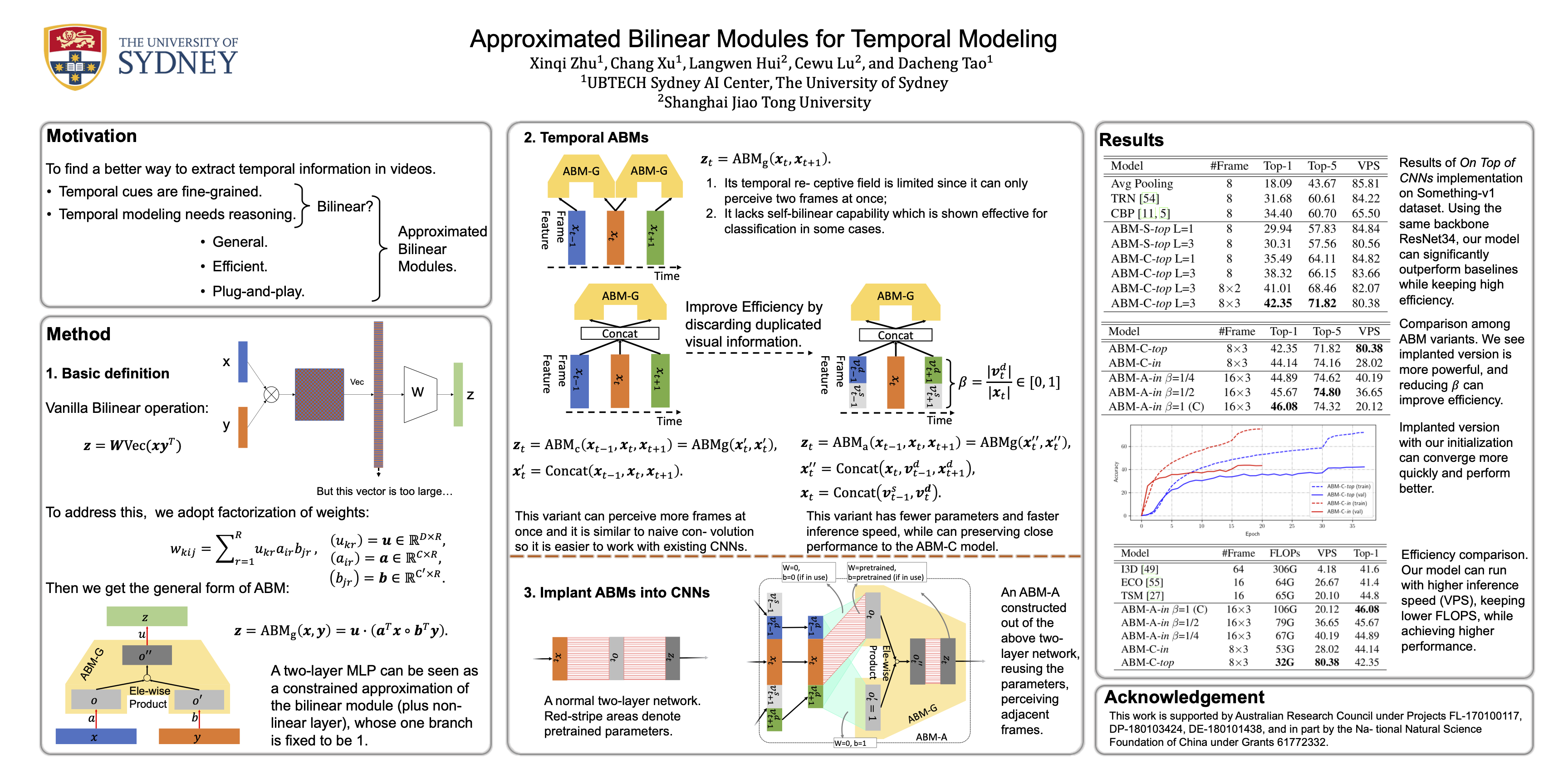We consider two less-emphasized temporal properties of video: 1. Temporal cues are fine-grained; 2. Temporal modeling needs reasoning. To tackle both problems at once, we exploit approximated bilinear modules (ABMs) for temporal modeling. There are two main points making the modules effective: two-layer MLPs can be seen as a constraint approximation of bilinear operations, thus can be used to construct deep ABMs in existing CNNs while reusing pretrained parameters; frame features can be divided into static and dynamic parts because of visual repetition in adjacent frames, which enables temporal modeling to be more efficient. Multiple ABM variants and implementations are investigated, from high performance to high efficiency. Specifically, we show how two-layer subnets in CNNs can be converted to temporal bilinear modules by adding an auxiliary-branch. Besides, we introduce snippet sampling and shifting inference to boost sparse-frame video classification performance. Extensive ablation studies are conducted to show the effectiveness of proposed techniques. Our models can outperform most state-of-the-art methods on Something-Something v1 and v2 datasets without Kinetics pretraining, and are also competitive on other YouTube-like action recognition datasets.
- Python 3.6.8
- PyTorch 1.1.0
- Torchvison: 0.3.0
git clone https://github.com/zhuxinqimac/abm-pytorch.git
Download Something-Something v1 and v2 from https://20bn.com/datasets/something-something/v1 and https://20bn.com/datasets/something-something/v2 respectively.
We provide converted datalists in folders something_v1_list and something_v2_list. You need to modify the paths in datalists (e.g. something_v1_trainlist.txt) to fit your own machine. Each line in datalists contains a video folder of frames, n_frame, and class number.
For optical flow of Something-Something v1, you may need to use code from https://github.com/yangwangx/denseFlow_gpu to extract it.
For Something-Somehting v2, follow https://github.com/metalbubble/TRN-pytorch to extract rgb frames and optical flow.
You can use scripts provided in res_train.sh to train different models. For example, to train an implanted ABM model with backbone res34, snippet sampling 3 (denoted as new_length in code), 16 frames, and RGB modality, you can run:
python main.py something RGB \
./something_v1_list/something_v1_trainlist.txt \
./something_v1_list/something_v1_vallist.txt \
--arch res_iabp_34 \
--weight-decay 5e-4 \
--eval-freq 1 \
--new_length 3 \
--num_segments 16 \
--gd 20 --lr 0.001 --lr_steps 25 40 \
--epochs 50 -b 24 -j 8 --dropout 0.5 \
--short_len 16 \
--result_path sth_v1_results/iabp/rgb_res34
Use the script res_eval.sh to evaluate a trained model. A trained model for this configuration has been provided: https://drive.google.com/open?id=1jvdJzVV02GWAQa79KOU2itvjPWfSTs_a
python main.py something RGB \
--evaluate \
./something_v1_list/something_v1_trainlist.txt \
./something_v1_list/something_v1_vallist.txt \
--arch res_iabp_50 \
--new_length 1 \
--num_segments 16 \
-b 24 -j 8 \
--short_len 16 \
--result_path sth_v1_results/iabp/rgb_res50 \
--resume sth_v1_results/iabp/rgb_res50/_rgb_ep_35_checkpoint.pth.tar
If you use this code or idea, please cite our paper:
@inproceedings{ABM_iccv19,
author={Xinqi Zhu and Chang Xu and Langwen Hui and Cewu Lu and Dacheng Tao},
title={Approximated Bilinear Modules for Temporal Modeling},
booktitle={ICCV},
year={2019}
}

